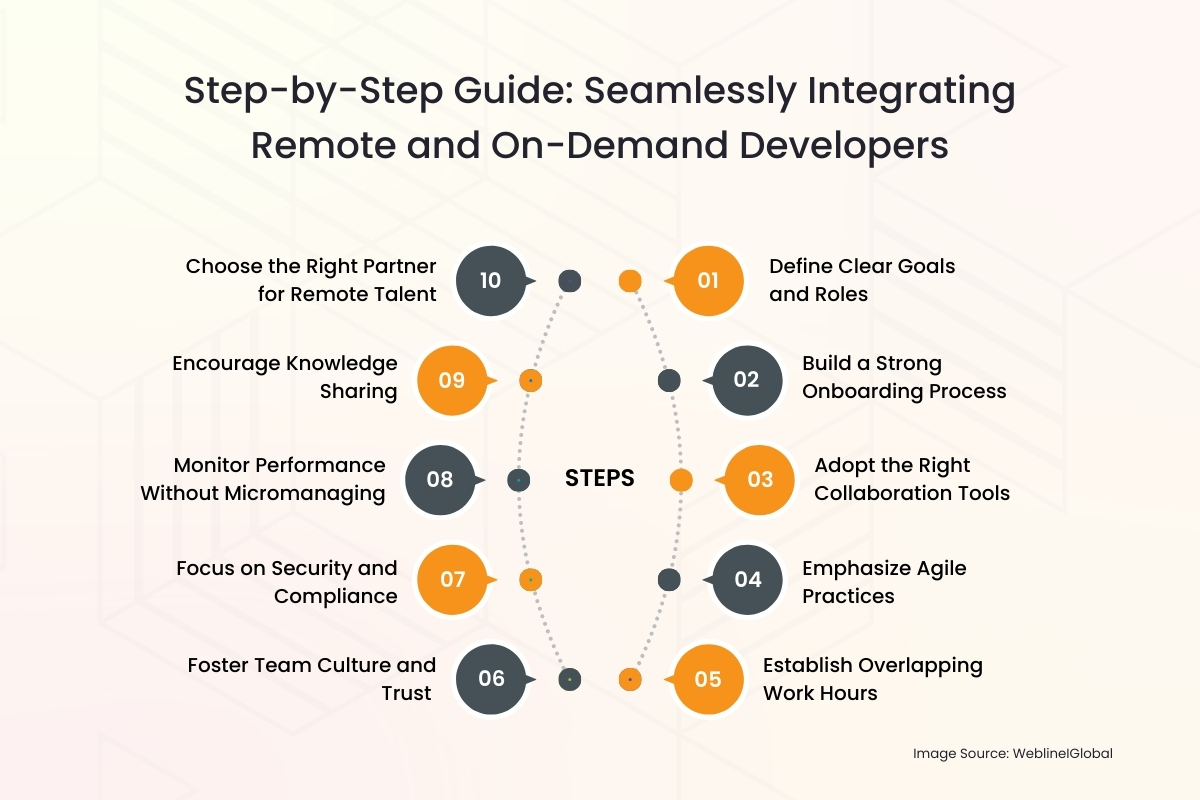
In today’s fast-paced digital world, enterprises face immense pressure to innovate, deliver projects faster, and scale IT capabilities without disrupting budgets. As technology evolves, the need for specialized expertise often outpaces the availability of local resources. This is where the ability to hire on-demand developers and remote engineering teams becomes not just a competitive advantage, but a necessity for fast-moving enterprises.
However, while companies recognize the benefits of extending their workforce with on-demand app developers, the real challenge lies in seamless integration. Without the right strategies, misalignment between in-house teams and remote talent can lead to communication breakdowns, cultural mismatches, and project inefficiencies.
This blog will walk you through a complete roadmap on how enterprises can seamlessly integrate remote and on-demand developers into in-house teams, maximizing productivity, minimizing risks, and achieving scalable growth.
Need skilled On-Demand Developers fast? Start building your dream team today!
Why Remote and On-Demand Developers Are Crucial Today
Before diving into integration strategies, it’s important to understand why the model of hiring on-demand developers and remote teams has become the go-to solution for enterprises of all sizes.
In an environment where digital transformation is no longer optional but essential, businesses cannot afford delays in project delivery or compromises in quality. That’s where the flexibility of remote and on-demand app developers makes a real difference.

1. Access to Global Talent
The most skilled developers are not always sitting in your city or even your country. By choosing to hire remote developers, companies can access a global pool of expertise across technologies, industries, and frameworks. This eliminates geographical limitations and allows enterprises to bring in the right skills at the right time.
2. Scalability at Speed
Business cycles often demand rapid scaling, especially during product launches or large client projects. With on demand app developers, companies can quickly expand their teams to handle workload spikes and then scale back down when demand stabilizes — without the long-term commitments of permanent hiring.
3. Cost Efficiency
Maintaining large in-house teams full-time can significantly increase operational costs. By leveraging on demand developers, organizations reduce overhead expenses while ensuring they pay only for the expertise they need, when they need it.
4. Specialized Expertise
Not all projects require generalists. Sometimes niche skills — such as blockchain, AI, or cybersecurity — are needed. Remote specialists can step in immediately and close these skill gaps.
At WeblineGlobal, powered by WeblineIndia’s offshore development hub, we’ve witnessed enterprises achieve faster delivery, cost savings, and efficiency improvements by embracing this model. The real question is: how do you integrate these professionals seamlessly into your in-house setup?
The Core Challenges of Integration
Enterprises often stumble when merging in-house and external resources. Here are some of the most common challenges faced:
- Communication Barriers due to time zones, language, or different work styles.
- Cultural Gaps that affect collaboration and team cohesion.
- Security Concerns when remote developers access company systems or sensitive data.
- Management Issues around task ownership, accountability, and performance tracking.
- Workflow Alignment, where external resources may not be accustomed to your tools or processes.
Without a structured approach, these hurdles can outweigh the benefits of hiring on-demand developers.
Step-by-Step Guide: Seamlessly Integrating Remote and On-Demand Developers
When enterprises hire remote developers or bring in on-demand app developers, success depends on more than just technical expertise. It’s about building cohesion, aligning processes, and ensuring everyone feels like part of the same team. Below is a practical 10-step guide with examples to make integration smoother and more effective.

Step 1: Define Clear Goals and Roles
The biggest cause of misalignment is vague expectations. Before adding external talent, define the “why” and the “what.”
- Decide whether on-demand developers are needed for short-term feature development, bug fixes, or long-term innovation.
- Clarify which deliverables they will own versus what in-house engineers will handle.
- Create a visual role map so responsibilities don’t overlap.
Example: A fintech company hired three on-demand app developers for API integration. By clearly assigning them backend API work while the in-house team handled UI, they avoided duplication and met deadlines smoothly.
Step 2: Build a Strong Onboarding Process
Onboarding sets the tone for productivity. If external developers don’t understand your systems or culture, friction arises later.
- Share internal documentation, coding standards, and workflow guidelines.
- Provide logins and access to repositories, tools, and communication platforms right away.
- Host a welcome session to introduce them to the team and culture.
Example: A retail SaaS client onboarded remote developers with a one-week knowledge transfer led by WeblineGlobal. This accelerated ramp-up time and made the remote team productive within days instead of weeks.
Step 3: Adopt the Right Collaboration Tools
Remote integration fails without the right tech stack. Tools make distributed work seamless.
- Communication: Slack, Teams, or Zoom for daily syncs.
- Project management: Jira or Trello for visibility.
- Code collaboration: GitHub, GitLab, or Bitbucket.
- Knowledge sharing: Confluence, Notion, or Google Workspace.
Example: A healthcare client used Slack for chats, Jira for tickets, and Confluence for documentation. With everyone — including on-demand developers — on the same stack, collaboration was transparent and effortless.
Step 4: Emphasize Agile Practices
Agile keeps distributed teams aligned and adaptable. With its iterative approach, it’s ideal for mixed in-house and remote groups.
- Hold daily stand-ups to align progress and address blockers.
- Use sprint planning to define achievable short-term goals.
- Run retrospectives to continuously refine processes.
Example: A logistics startup integrated four on-demand app developers into their Scrum sprints. Within two cycles, the remote team was fully aligned, delivering features alongside in-house staff with no delays.
Step 5: Establish Overlapping Work Hours
Time zones can create friction if there’s zero live communication. A few overlapping hours are enough to sync effectively.
- Schedule at least 2–3 hours of overlap for meetings and collaboration.
- Use these hours for urgent discussions, reviews, or brainstorming.
- Outside overlap, rely on asynchronous communication like Jira or recorded Loom videos.
Example: A US-based client working with WeblineIndia’s offshore hub scheduled a 2-hour overlap window in the morning. This small adjustment removed delays and allowed real-time decision-making with remote developers.
Struggling to align remote hires? Let WeblineGlobal streamline your developer onboarding.
Step 6: Foster Team Culture and Trust
Culture drives productivity. If external hires feel excluded, collaboration weakens.
- Invite on-demand developers to brainstorming sessions and company-wide updates.
- Celebrate milestones together, even virtually.
- Organize informal team-building activities online.
Example: One client set up “virtual coffee chats” between in-house staff and on-demand app developers. These casual sessions built rapport and reduced the feeling of “us vs. them.”
Step 7: Focus on Security and Compliance
Data security is a major concern when working with distributed teams. Establish strict protocols upfront.
- Require VPNs, MFA, and secure access policies.
- Have remote hires sign NDAs and compliance agreements.
- Clearly outline protocols for IP ownership and data handling.
Example: A European enterprise needed GDPR-compliant mobile app development. WeblineGlobal ensured that on-demand developers followed strict access controls, keeping compliance intact while delivering the project.
Step 8: Monitor Performance Without Micromanaging
Remote developers need autonomy to thrive, but they also need accountability structures.
- Define measurable KPIs and outcomes for each developer.
- Use dashboards in Jira or Trello to track progress.
- Hold weekly reviews to share feedback and unblock challenges.
Example: An e-commerce platform tracked velocity metrics for their on-demand developers. Rather than daily checks, weekly reports gave management insights without stifling autonomy.
Step 9: Encourage Knowledge Sharing
Integration succeeds when knowledge flows freely across teams. Without it, expertise gets siloed.
- Encourage pair programming between in-house and remote hires.
- Maintain a centralized knowledge hub or wiki.
- Assign mentors to remote developers for smoother alignment.
Example: At WeblineGlobal, we often assign a “buddy” from the client’s in-house team to each on-demand developer. This speeds up learning and reduces confusion in the early stages.
Step 10: Choose the Right Partner for Remote Talent
Not every provider of on-demand developers delivers the same quality. Picking a partner with the right framework is key.
- Look for proven experience across industries and technologies.
- Ensure they offer structured onboarding and cultural alignment.
- Verify strong security, scalability, and compliance processes.
Example: Enterprises that partnered with WeblineGlobal, supported by WeblineIndia’s offshore hub, consistently saw faster ramp-ups and fewer integration issues compared to freelancers or unstructured agencies.
A Seamless Integration Success Story
One of our enterprise clients, a US-based healthcare SaaS provider, needed to expand their mobile development team rapidly. Their challenge was finding skilled on-demand app developers proficient in HIPAA-compliant solutions.
The benefits they got by partnering with WeblineGlobal:
- They onboarded 6 remote developers within two weeks.
- Our offshore hub ensured time zone overlap with their in-house US team.
- Standardized onboarding aligned external developers with existing workflows.
- The project was delivered 30% faster with zero security breaches.
This is a classic example of how structured integration drives results.
The Future of Hiring Remote and On-Demand Developers
The hybrid workforce model—blending in-house teams with on-demand developers—is fast becoming the standard for enterprises looking to scale efficiently and innovate continuously. With markets changing rapidly, companies need agile, flexible teams that can respond to evolving demands without being limited by location. By integrating remote developers, businesses can access specialized skills, scale resources on demand, and maintain high productivity.
Emerging technologies and practices will continue to transform how distributed teams collaborate and deliver results:
- AI-Powered Collaboration Tools: AI will automate routine tasks, monitor progress, and flag potential bottlenecks. Predictive analytics and intelligent assistants will help managers support on-demand app developers in real-time, enhancing workflow efficiency.
- Cloud-Native Development Environments: Developers can work on the same live codebase simultaneously, with instant access to testing, staging, and deployment tools. This reduces errors and ensures alignment across teams.
- Virtual Reality Team Spaces: VR enables immersive meetings, pair programming, and brainstorming sessions, helping remote workers feel as integrated as in-house staff.
- Automated Code Review and QA Tools: AI-driven code reviews and automated testing platforms will streamline quality assurance, making it easier for distributed teams to maintain high standards.
- Integrated Knowledge Management Systems: Centralized documentation and collaboration platforms will allow teams to share learnings and solutions instantly, reducing knowledge silos and improving team efficiency.
- Flexible Work Scheduling Platforms: Intelligent scheduling tools will coordinate availability across time zones, allowing remote developers and in-house teams to collaborate with minimal friction.
Enterprises that adopt these tools and practices early will be able to build hybrid teams that are agile, productive, and scalable. The future workforce will be defined not by location but by collaboration, technological integration, and flexibility. Forward-thinking enterprises are already preparing to embrace this reality.
Let us Make Integration Work for you
Hiring on-demand developers, on-demand app developers or choosing to hire remote developers isn’t just about filling skill gaps. It’s about extending your in-house team’s capabilities seamlessly.
To succeed, enterprises must:
- Define goals clearly.
- Leverage the right tools.
- Build trust and inclusion.
- Prioritize security.
- Partner with experienced providers like WeblineGlobal.
With the right approach, your extended workforce becomes a true extension of your in-house team — driving innovation, scalability, and success.
Why WeblineGlobal is Your Best Technology Partner?
At WeblineGlobal, we help enterprises scale efficiently with our remote engineers and software development experts. Backed by WeblineIndia’s offshore development hub, we provide the perfect blend of affordability, expertise and cultural alignment. Whether you need to hire remote developers for short-term projects or long-term engagements, we ensure seamless integration with your in-house teams.
Social Hashtags
#OnDemandDevelopers #RemoteDevelopers #TeamIntegration #SoftwareDevelopment #TechInnovation #DigitalTransformation #HireDevelopers #WeblineGlobal
Ready to hire top On-Demand Developers? Why wait—scale your team with WeblineGlobal now!




